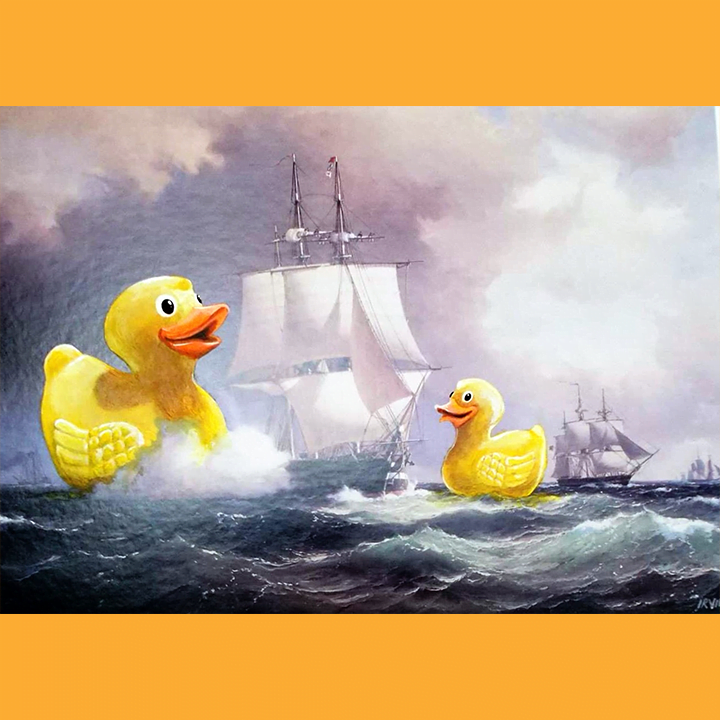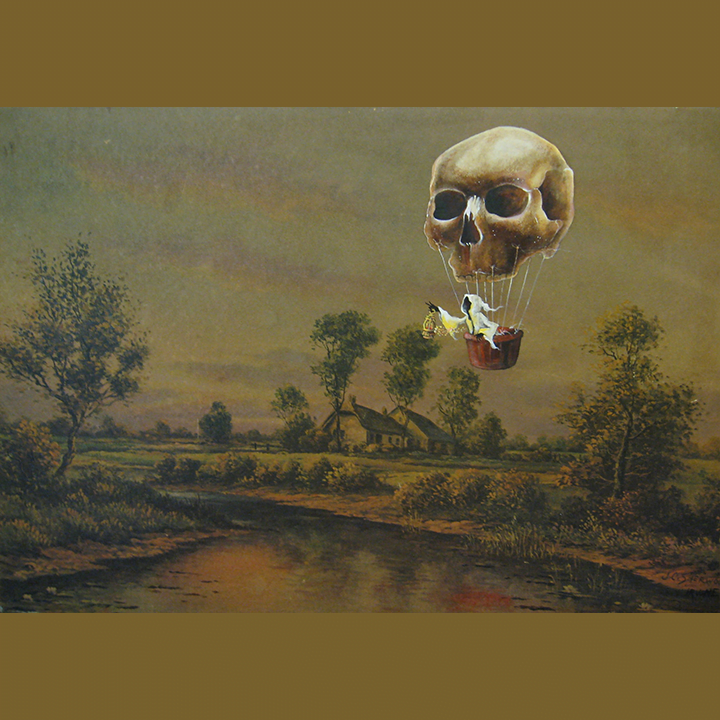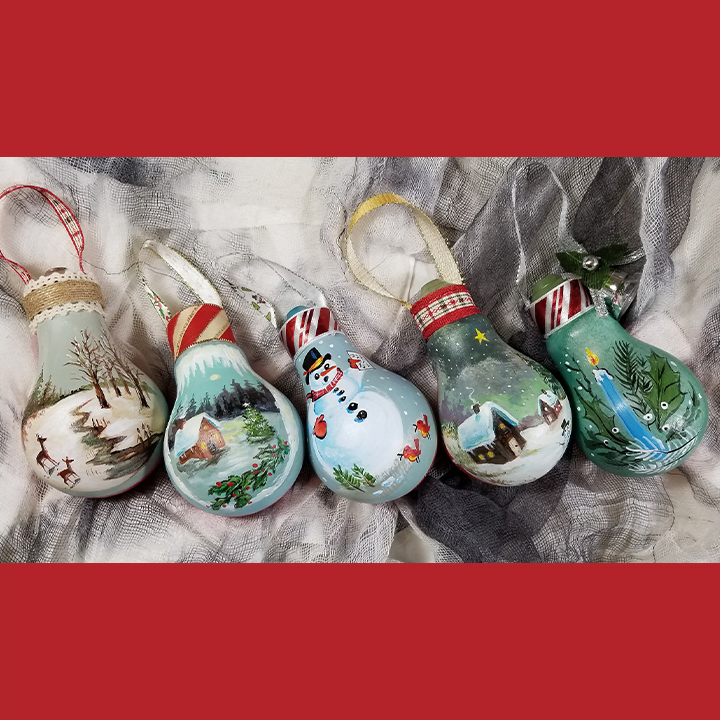Q&A with David Irvine from The Gnarled Branch
David Irvine is the multi-talented artist behind the Gnarled Branch. He is known for his imaginative ‘Re-Directed Paintings’, whimsical furniture, original paintings, painted burnt out light bulb ornaments, salvaged record paintings, and so much more. You can visit his Etsy shop here! You can see throughout his work that there is an interest with popular characters which brings life to the rural paintings he often re-directs. Irvine will match the original artist’s style within the painting or counter it intentionally, but he always leaves the original signature clear to see. There’s a story behind each of his works, including the painting “The Last Trick or Treater” which is one of Irvine’s favorites. Read on to learn more about David’s work, inspiration, and so much more.
What is your background – in addition, did your upbringing prompt a specific reference point within your work? Is your work informed by certain concepts or themes from your childhood, background, socioeconomic status, where you lived or were raised?
DI: I was fortunate to be raised by parents who appreciated all the arts. Going to see theatre shows, music performances, and gallery exhibits were always exciting. I was encouraged to develop with the visual arts and musically as well with regular music lessons and art lessons. They were at first concerned when I decided to pursue a career in the visual arts, as they knew it can be a real struggle – but were fully supportive and excited that I was accepted into art college to study illustration.
How does this impact how you see the world and create art?
DI: It’s no secret the art world can be very snooty, takes itself far too seriously and that is a real shame. In a lot of the genres that I do- I am always considering humor and fun as elements in a piece. Especially during these difficult pandemic times, art needs to uplift and provide smiles and not be staunch, same old -same old themes that have been done over and over.
Do you have an educational background or experiences that have contributed to your evolution as an artist?
DI: I studied illustration at Sheridan College, and throughout my childhood would occasionally take art lessons. The rest was experimenting and being self-taught with various mediums and medium combinations. I taught visual art to a wide range of ages through community night school and was an art tutor to a terrific student with special needs. Those were very memorable years.
What does your work aim to say?
DI: I do so many different genres of art, I think there’s a spectrum of what I want to communicate…. from making people laugh and feel good — to the darker, macabre work to scare and bring the viewer into a world that they may not feel comfortable being in… I guess I make art to get a reaction… not just creating something for its sole purpose is to look pretty and match the sofa.
Is there a particular artist that inspired you to pursue art?
DI: My grandfather was an accomplished amateur painter and I’d watch him work and see the pieces he did… maybe that was the first seed…Other than that I would always sign out art books from the library and soak in everything from master painters to illustrators and cartoonists who worked presently.
Whose techniques do you study or admire?
DI: There are so many — but in high school, I always enjoyed Ralph Steadman ink illustrations, Van Gogh for his boldness, Rene Magritte for the unique and surreal visuals … Currently I’ll search through websites like Tumblr or magazines like Juxtapoz and discover artists both old and new who mix unusual mediums or have their own unique style.
How do you cultivate a collector base?
DI: When I first started as a fine artist, I didn’t have a computer- the internet wasn’t a thing yet, so I was reliant on physically going to galleries and public places to show my work. From little gift or record shops to restaurants and cafes. Now with technology, it’s just a matter of updating and refreshing social media, submitting articles to websites, or being lucky and being featured by a blog, website, or podcast…it all helps and a lot more convenient to be able to post an instructional video from home, or post new work in progress photos to a website, than to lug workaround or mail promo packages out to land a show. Once a collector is on board, having top-notch customer service skills and excellent communication is key…
What inspires you to paint?
DI: I’ll have a lot of eureka moments as I’m sketching or planning out new works or series….and I have to then see that eureka image come to fruition. It would drive me bananas having a good idea sitting there on a page and going nowhere. As well it is my chosen job- so those bills must get paid.
How do you look for new ways to challenge yourself?
DI: I get bored very easily… so challenges are always put in place to not get bored. Every artist has a spectrum of color they usually gravitate to when creating a piece…I like to switch things up and use the colors I don’t normally use or come up with different color combinations/ mixing. I’ll even wear tinted sunglasses so the colors I think I’m using wind up making happy accidents when I look at the piece without the sunglasses. Using oil pastels with acrylic paint… various types of inks and papers …are many variables that can be used to break away from regular tendencies when approaching a piece.
Do you have a favorite painting that you have completed? If so, can you tell us the story behind it?
DI: I did a solo show a few years ago with Halloween as the main theme. A few favorite paintings came out of that show including one called the Last Trick or Treater. It showed a bird’s eye view looking down onto an old tyme small hamlet, and one child in a ghost costume running down a street with a lantern. I think I captured the quiet of the night, and the bit of panic the boy was having as he was quickly trying to get home.
What inspired Re-Directed painting for you?
DI: When I first started as a fine artist, I had very little money and art supplies and framing was expensive. I would frequent yard sales and thrift shops to purchase old frames, lithographs on board, and existing canvas prints to paint over and frame. Around 2009 I started to paint weird imagery in an existing piece and then later one piece my Mom was getting rid of was a seascape -where I had the immediate vision of two reapers playing with a beachball. I painted them in, shared them on social media and things snowballed rather quickly from there. I came up with the term re-directed as I used that as a tag and hoped people would begin to associate it with me…and it worked! Other people now use that term – which is fine… I prefer that to ‘Improved Painting’…as I never meant to demean the original artist. All these redirected pieces were salvaged and unwanted and quite likely wind up as landfill. I hate waste and seeing potential thrown away. This was just another method to upcycle. I’ll spend considerable time touching up the piece from scratches, buffs or sun/ water damage then I’ll add in my own visions. ..never covering the signature of the original artist. Research is always done prior to any painting to insure it’s not of significant value. I rarely work on originals, always lithographs, canvas prints, or anonymous paint by numbers.
Is there anything that you would like to add?
DI: Even though most know my work through my ongoing Re-Directed thrift art series, I look forward to continuing my upcycling work (hand-painted ornaments using salvaged burnt-out light bulbs, pop art paintings on discarded, damaged vinyl records, beer cap pins, and redoing/painting discarded wooden furniture…) and preventing landfill.
Follow The Gnarled Branch:










